

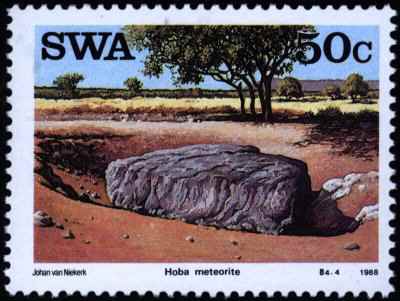
Hoba Meteorite Stamp
Source : National Post of Namibia
For an introduction please scroll down
Coordinates :
19°34 'S , 17°55 'E : Farm Hoba West, Grootfontein, Otavi Mountainland, NE -
Namibia
To see the Hoba meteorite on Google Earth, please click here.
The Hoba Meteorite is the largest known meteorite and likewise the largest known single mass of native iron known on earth. There are some other large iron meteorites around, the most prominent of which are summarized in the table below. There are also the remarkable large iron masses from Ovifak in Greenland - reaching 25 tons and of undoubtly terrestrial origin - which are now (said to be) housed in the National Museum in Copenhagen. However, all these other irons are not nearly as large as the Hoba Meteorite.
The Hoba meteorite was discovered in 1920 by the farmer of the Farm Hoba West near Grootfontein in northern Namibia (at that time called "South West Africa). As the story goes, the farmer was ploughing through one of his fields, when he heard an odd metallic screetch and the ox-driven plough suddenly came to a full stop. Upon closer investigation the farmer discovered a huge boulder of iron, measuring roughly 3 by 3 meter. Due to its immense weight of roughly 60 tons (see below) it was never seriously attempted to remove the boulder nor was it feasible to cut the iron into smaller pieces. So the Hoba meteorite remained on the site of its discovery to this very day.>
The iron mass of the Hoba measures 2.95 x 2.84 meters and it has an average thickness of about 1 m (1.22 m maximum and 0.75 m minimum). The meteorite displays a very atypical form of a roughly quadratic slab. The total weight is according to various sources given as 55 to 61 tons, the chemical composition as 82.4 % iron, 16.4 % nickel, 0.8 % Cobalt and traces of other metals. Not counting any ironhydroxides, which form a thin oxydation layer on its surface. The calculated weight however seems to me a bit low, given the high nickel and cobalt content and therefore the true weight is probably rather about 65 - 70 tons, assuming a mean thickness of 1 m.
Some aspects of the nature of the Hoba meteorite are truely puzzling. On the one hand, the meteorite belongs, despite its huge size, to a very rare class of meteorites and is defined as nickel - rich ataxite. Ataxites consists almost entirely out a dense packing of the meteorite mineral taenite and do not display the otherwise typical 'Widmannstaettensche Figuren' on acid edging. Another enigma is the absence of any crater like structure. The meteorite was covered by a thin crust of calcrete at the time of discovery, but upon excavation no signs of the otherwise very typical temperature & pressure induced shock phenomenae, nor any burried remains of a crater structure were reported. During excavation an odd "Iron shale" = an odd magnetic (!) and limonite rich laminated sediment was observed in close proximity to the meteorite mass, which most probably results from long time weathering. All this support the theory, that the meteorite with its unusual form hit the earth - estimated 80.000 B.C. ago - at an very low angle, junping like a stone on water from place to place until it reached its present position.
Since its discovery the Hoba meteorite lost about half a ton of its substance through the taking of scientific samples and especially through 'specimen taking' by tourists and travellers. Marks of iron saws can be recognized easily at many places on the meteorite surface. In 1955 the Hoba was declared a National Monument. However, vandalizing of the meteorite continued until the Rössing Foundation funded a thoroughly restauration and preservation of the meteorite in 1988. In the course of the restauration work the whole meteorite was excavated completely and now all faces of the iron mass can be studied in detail. For a small fee the Hoba iron can be visited, touched and even climbed for spectacular photo - shooting "Standing on matter from Outer Space". So the Hoba remains the largest known iron meteorite on our earth*, visited by thousands tourists throughout the year, many of which come to this beautiful southern african country for its extremely clear skies, where they eventually may discover an even larger iron meteorite aiming for Africa...
Table of the ten largest known iron meteorites on earth Source : Information based on : http://rgregio.astrodatabase.net/meteoritos.htm
Recent photo of the Hoba meteorite : In situ and preserved as National Monument
Photo : www.astronomie.de
Historical photos of the Hoba Meteorite :
A group of german geologists at the Hoba, back in 1929
Photo Source : Peter Marmet, Switzerland
Early traveller visiting the exposed Hoba meteorite, around 1955
Photo Source : Peter Marmet, Switzerland
Hoba Meteorite : Photo before preservation, about 1960
Photo Source : unknown
There are many good websites around about astronomy and meteorites, many of which give more or less details about the Hoba meteorite. Peter Marmet, Switzerland maintains an excellent website about meteorites, including very detailed information about the Hoba. Please click here to visit his website.
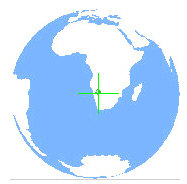
Meteorite :
Discovery / Year :
Weight in tons ::
Location 2006 :
Hoba
Hoba West, Namibia / 1920
60
in situ
Campo de Cielo / El Chaco
Chaco, Argentina / 1969
37
in situ
Ahnigito / Cape York
West Greenland / 1894
31
Museum of Natural History, New York
Armanty
Xinjiang, China / 1898
28
Urumqui Museum, Xinjian, China
Bacubirito
Sinaloa, Mexico / 1806
22
Centro de Ciencias, Sinaloa, Mexico
Agpalilik
East Greenland / 1963
20
Copenhagen, Denmark
Mbosi
Rungwe, Tanzania / 1930
16
in situ
Willamete
Clackamas, Oregon / 1902
14
Museum of Natural History, New York
Chupaderas I
Chihuahua, Mexico / 1852
14
Palacio de Minerais, Mexico City
Mundrabilla
West Australia / 1966
11,5
Museum of West Australia, Perth
Mineralogy :
Nickeliferous iron, with some iron hydroxide formation on the surface, heavily weathered at the bottom contact
Crystal Size :
The individual crystal size of the Hoba meteorite is rather small, but the mass as such measures roughly
3 x 3 m x 1 m, weighing about 60 tons (or rather 65 - 70 tons according to our own calculation.)
Geology & Origin :
Iron meteorite of extraterrestrial origin and genesis
Current status :
A major namibian tourist attraction, which is
preserved as national monument.
Remarks :
A must see for any namibian visitor with interest
in geology or astronomy
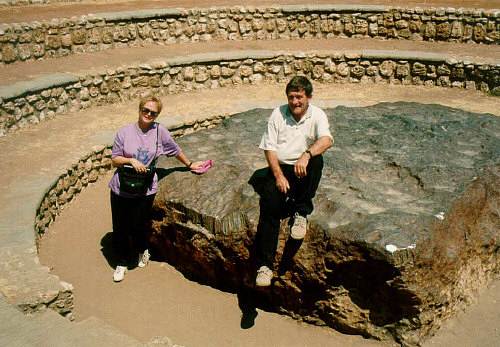
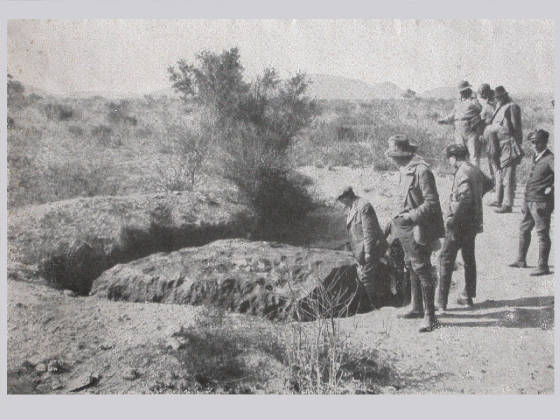
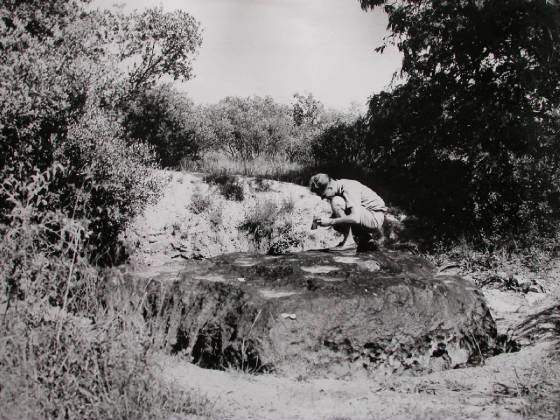
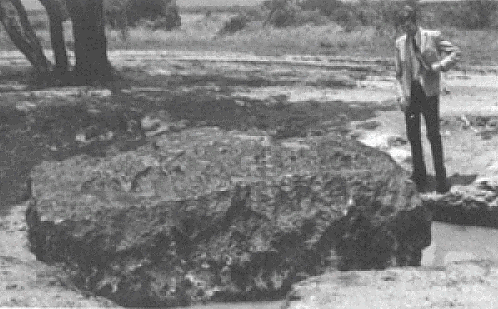
Have you been at the site ? Do you know more details or have discovered any errors ?
Click here to contact us !